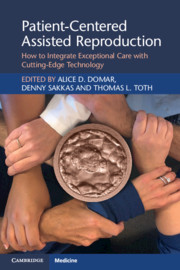26 results
Chapter 25 - Sperm Selection in the Laboratory
- from Section 4 - Laboratory Evaluation and Treatment of Male Infertility
-
-
- Book:
- Men's Reproductive and Sexual Health Throughout the Lifespan
- Published online:
- 06 December 2023
- Print publication:
- 16 November 2023, pp 197-203
-
- Chapter
- Export citation
Copyright page
-
- Book:
- Patient-Centered Assisted Reproduction
- Published online:
- 02 March 2020
- Print publication:
- 19 March 2020, pp iv-iv
-
- Chapter
- Export citation
Index
-
- Book:
- Patient-Centered Assisted Reproduction
- Published online:
- 02 March 2020
- Print publication:
- 19 March 2020, pp 175-180
-
- Chapter
- Export citation
Contents
-
- Book:
- Patient-Centered Assisted Reproduction
- Published online:
- 02 March 2020
- Print publication:
- 19 March 2020, pp v-v
-
- Chapter
- Export citation
Chapter 5 - The IVF Cycle to Come: Laboratory Innovations
-
-
- Book:
- Patient-Centered Assisted Reproduction
- Published online:
- 02 March 2020
- Print publication:
- 19 March 2020, pp 54-66
-
- Chapter
- Export citation
Introduction
-
-
- Book:
- Patient-Centered Assisted Reproduction
- Published online:
- 02 March 2020
- Print publication:
- 19 March 2020, pp 1-2
-
- Chapter
- Export citation
Contributors
-
- Book:
- Patient-Centered Assisted Reproduction
- Published online:
- 02 March 2020
- Print publication:
- 19 March 2020, pp vi-viii
-
- Chapter
- Export citation

Patient-Centered Assisted Reproduction
- How to Integrate Exceptional Care with Cutting-Edge Technology
-
- Published online:
- 02 March 2020
- Print publication:
- 19 March 2020
Chapter 20 - Physiology and Culture of the Early Human Embryo
- from Section 4 - Oocyte and Embryo Culture
-
-
- Book:
- How to Prepare the Egg and Embryo to Maximize IVF Success
- Published online:
- 04 January 2019
- Print publication:
- 17 January 2019, pp 232-244
-
- Chapter
- Export citation
Chapter 19 - Fertilization and Complete Fertilization Failure in Human IVF
- from Section 4 - Oocyte and Embryo Culture
-
-
- Book:
- How to Prepare the Egg and Embryo to Maximize IVF Success
- Published online:
- 04 January 2019
- Print publication:
- 17 January 2019, pp 224-231
-
- Chapter
- Export citation
41 - Repeated fertilization failure with normal sperm and MII oocytes
-
-
- Book:
- Case Studies in Assisted Reproduction
- Published online:
- 05 February 2015
- Print publication:
- 22 January 2015, pp 140-144
-
- Chapter
- Export citation
Contributors
-
-
- Book:
- Case Studies in Assisted Reproduction
- Published online:
- 05 February 2015
- Print publication:
- 22 January 2015, pp ix-xiv
-
- Chapter
- Export citation
Contributors
-
-
- Book:
- Paternal Influences on Human Reproductive Success
- Published online:
- 05 April 2013
- Print publication:
- 11 April 2013, pp ix-x
-
- Chapter
- Export citation
Chapter 16 - Sperm selection and ART outcome: a means to overcome the effects of aging and abnormal spermatogenesis?
-
-
- Book:
- Paternal Influences on Human Reproductive Success
- Published online:
- 05 April 2013
- Print publication:
- 11 April 2013, pp 165-173
-
- Chapter
- Export citation
Chapter 27 - Metabolomics
- from Section 5 - Laboratory
-
-
- Book:
- How to Improve your ART Success Rates
- Published online:
- 05 July 2011
- Print publication:
- 30 June 2011, pp 147-151
-
- Chapter
- Export citation
Contributors
-
-
- Book:
- How to Improve your ART Success Rates
- Published online:
- 05 July 2011
- Print publication:
- 30 June 2011, pp viii-xii
-
- Chapter
- Export citation
Chapter 25 - Day of embryo transfer
- from Section 5 - Laboratory
-
-
- Book:
- How to Improve your ART Success Rates
- Published online:
- 05 July 2011
- Print publication:
- 30 June 2011, pp 139-142
-
- Chapter
- Export citation
Contributors
-
-
- Book:
- Human Assisted Reproductive Technology
- Published online:
- 16 May 2011
- Print publication:
- 31 March 2011, pp ix-xii
-
- Chapter
- Export citation
Chapter 20 - Sperm diagnosis:
-
-
- Book:
- Human Assisted Reproductive Technology
- Published online:
- 16 May 2011
- Print publication:
- 31 March 2011, pp 223-231
-
- Chapter
- Export citation
Contributors
-
-
- Book:
- Infertility in the Male
- Published online:
- 19 May 2010
- Print publication:
- 24 September 2009, pp vii-x
-
- Chapter
- Export citation

